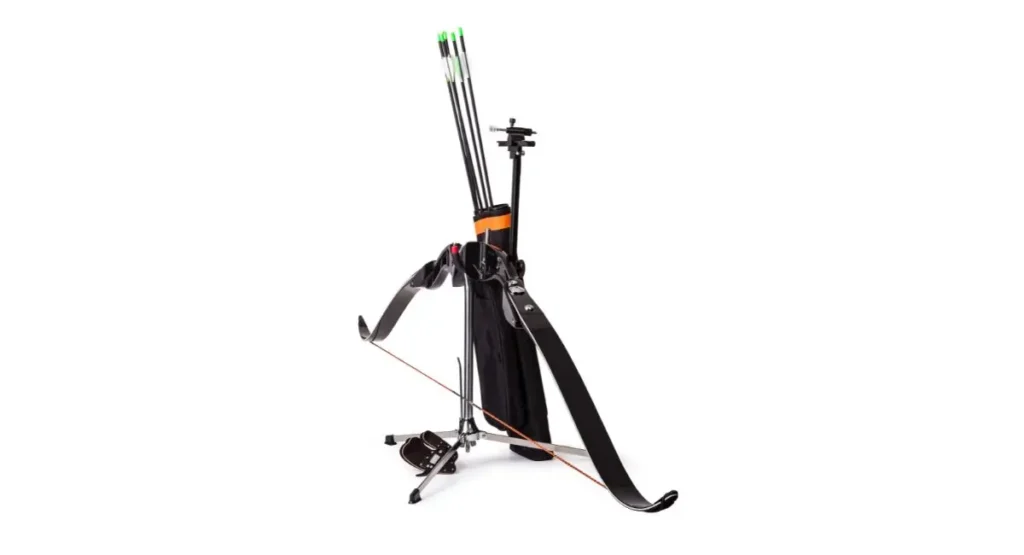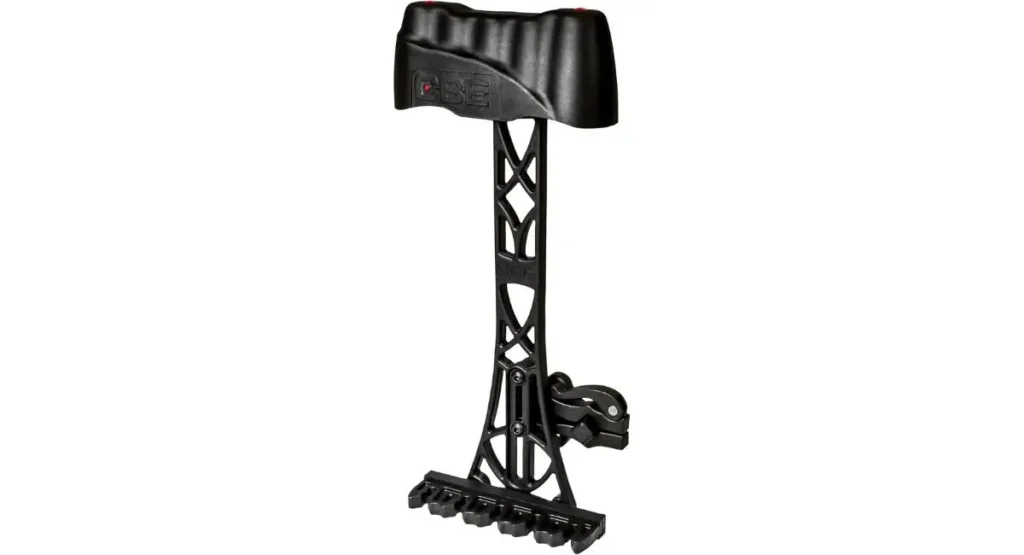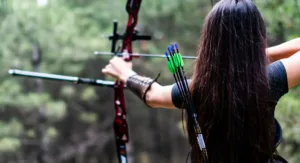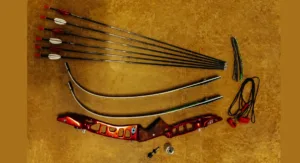When you think about honing your traditional archery skills, does the image of a quiver pop into your mind? Surprisingly, many archers pay no attention to this essential piece of gear. Yet, choosing the right quiver can significantly impact your experience, whether you’re a seasoned bowhunter or an outdoor enthusiast hitting the target range.
This guide dives deep into the fascinating world of traditional archery bow quivers. It covers their types, historical significance, and how to choose the appropriate fit for you.
Understanding Traditional Archery Quivers
In the extensive range of archery equipment, quivers are often overlooked. However, their role is indispensable, especially in traditional archery gear. A quiver isn’t just a container for arrows; it’s an extension of the archer, influencing shooting style and efficiency. This blog post will explore various quiver types, their historical context, and expert insights, ensuring you make an informed choice. Let’s start by understanding the importance of selecting the right quiver.
Why Quiver Choice Is Crucial For Archers
Every piece of archery equipment plays a pivotal role in performance, and quivers are no exception. The right quiver enhances accessibility, comfort, and balance, directly affecting how you shoot. Whether you’re into bowhunting quivers or target practice, a well-chosen quiver can refine your skills and performance. This guide helps you identify the best archery quivers by discussing their types, materials, and functionality.
Also Read : Master Your Aim With The Ultimate Guide To Archery Targets
Exploring Types of Traditional Archery Quivers
Archers have a plethora of quiver options, catering to different needs and preferences. Quiver types reflect traditional archery’s rich history and evolution. In this section, we’ll examine the different types of quivers, from back quivers to ground quivers. We’ll highlight their unique features and most beneficial use cases.
Back Quivers Unveiling The Classic Icon

Description and History: The back quiver is perhaps the most iconic type, often depicted in films and medieval illustrations. This quiver sits on the back, with arrows peeking over the shoulder, and has been a staple of traditional archery gear for centuries.
Pros and Cons: The main advantage of back quivers is their capacity; they can hold a lot of arrows and allow for quick retrieval. However, they may require some practice to pull arrows smoothly and can be cumbersome in dense woods.
Best Use Cases: Ideal for long-distance hiking and hunting, back quivers are favored by traditional bowhunters. They offer ample storage without hindering movement, making them suitable for long treks.
Expert opinion:
“The right quiver can make or break an archer’s experience. It’s not just about holding arrows; it’s about convenience, comfort, and performance.”
Alex Morgan, professional archer
Side Quivers Balance Accessibility And Style

Description and History: Side quivers, also known as hip quivers, hang from the waist and provide easy arrow access. Historically, they were used in various cultures, offering practicality and style.
Pros and Cons: Side quivers offer easy access, making them excellent for quick shooting. However, they can be less stable than other quiver types, especially when moving swiftly.
Best Use Cases: These quivers are suitable for archery competitions and target practice, where quick and easy access to arrows is essential.
Expert opinion:
“Each quiver type has its place in the world of archery. Understanding their differences and how they affect your shooting style can significantly improve your game.”
Dr. Oliver Hayes, Archery Historian
Hip Quivers Traditional Waist Convenience
Description and History: Similar to side quivers, hip quivers are worn at the waist, allowing arrows to hang freely. They have been used across cultures and time periods because of their ease of use.
Pros and Cons: Hip quivers offer excellent mobility and quick access to arrows. However, they may not hold as many arrows as back quivers and are less secure during vigorous activities.
Best Use Cases: Perfect for casual target practice and historical reenactments, hip quivers offer convenience and tradition.
Expert opinion:
“When it comes to traditional archery, the choice of quiver is almost as personal as the bow itself. It becomes an extension of the archer, reflecting their style and preferences.”
Emily Park, Traditional Archery Expert
Ground Quivers Stationary Precision

Description and History: Ground quivers are designed to be placed on the ground, providing a stable base for arrows. Their use dates back to early archery practices, offering a stationary option for precise shooting.
Pros and Cons: Ground quivers provide excellent stability, making them suitable for target practice. However, they are not portable, limiting their use to specific settings.
Best Use Cases: Ideal for stationary target practice and archery ranges, ground quivers offer precision and stability.
Expert opinion:
“The best quiver is one you don’t notice. It should be comfortable, secure, and not impede your movements. A well-designed quiver enhances your shooting experience.”
Michael Lee, Competitive Archer
Bow Quivers Integrated Convenience

Description and History: Bow quivers attach directly to the bow, offering a compact and integrated design. Modern archery has gained popularity for their convenience.
Pros and Cons: Bow quivers keep arrows within reach, enhancing portability. However, they can add weight to the bow, potentially affecting balance.
Best Use Cases: Ideal for bowhunters who prioritize mobility and quick access to arrows, bow quivers offer a convenient all-in-one solution.
Expert opinion:
“The best quiver is one you don’t notice. It should be comfortable, secure, and not impede your movements. A well-designed quiver enhances your shooting experience.”
Michael Lee, Competitive Archer
Also Read : Aim True With 3d Archery Targets And Hit The Mark Every Time
Choosing The Right Quiver For Your Needs
Selecting the most suitable quiver involves considering various factors, from archery style to personal preferences. In this section, we’ll guide you through the process of choosing the right quiver, offering practical tips and expert recommendations.
Factors To Consider When Choosing A Quiver
Archery Style and Personal Preference: Your shooting style and personal preferences significantly impact your quiver choice. Consider how you plan to use your quiver, whether for target practice, bowhunting, or historical reenactments.
Material and Durability: Quiver materials vary, from leather quivers to modern synthetic options. Evaluate the durability and aesthetics of each material to find one that suits your needs.
Comfort and Convenience: Comfort is key when selecting a quiver. Ensure it fits well and offers easy access to the arrows without hindering your movement.
Practical Tips For Testing Quivers
How to Test Different Quivers: Visit archery supply stores to try on different quivers and assess their fit and functionality. Testing them in person can help you determine which one feels comfortable.
Common Mistakes to Avoid: Avoid choosing a quiver solely based on appearance. Prioritize functionality and aesthetics over aesthetics.
Expert Recommendations: Seek advice from experienced archers and consult reviews to gain insights into different quiver types. Their expertise can guide you in making an informed decision.
Historical Context And Evolution Of Quivers
Quivers are intertwined with archery development. In this section, we’ll explore the historical background and evolution of quiver designs, shedding light on their cultural significance.
Historical Background Of Quivers
Ancient Origins: Quivers have been used for centuries, with evidence found in ancient civilizations worldwide. From Native American plains to Asian empires, quivers have played a significant role in archery history.
Evolution Over Time: Quiver designs evolved alongside advancements in archery techniques and materials. From wooden quivers to sophisticated modern designs, quivers have adapted to meet archers’ changing needs.
Cultural Significance: Quivers hold cultural significance in various regions, symbolizing status, skill, and heritage. Understanding their historical context adds depth to their modern applications.
Conclusion
In conclusion, selecting the right quiver is crucial for archers of all levels. Whether you’re drawn to leather quivers or bow quivers, your choice impacts your shooting experience. Explore different quiver types, consider your needs, and experiment to find the most suitable fit. To deepen your knowledge, explore expert articles and videos that provide further insights into traditional archery quivers.
Also Read : Mastering the Art of Bow Sights Maximizing Archery Accuracy
Frequently Asked Questions (FAQs)
What Is The Best Quiver For Beginners?
In the beginning, hip quivers are a good option because they are easy to use and accessible, which allows newcomers to focus more on learning.
How Do I Maintain Leather Quivers?
For a leather quiver to remain in good condition, clean it regularly with a damp cloth and apply leather conditioner to prevent it from drying out or cracking.
Can I Use A Bow Quiver For Target Practice?
It is true that bow quivers are suitable for target practice, but you should take into consideration their weight and balance when attached to the bow.
Where Can I Find Custom Quivers?
Quivers designed to meet your specifications can be found at specialized archery shops and online retailers that offer personalized options.
Are There Quivers Designed Specifically For Left-Handed Archers?
It is true that many quiver manufacturers offer left-handed options. When making your purchase, be sure to specify your preference.
In the dynamic world of traditional archery, choosing the right quiver is an art form that blends functionality with personal style. By exploring the diverse types and considering their historical significance, you’ll find a quiver that enhances your archery experience.
Recommended Articles
- The Ultimate Guide To Choosing Between Compound Bow vs Crossbow
- How To Carry A Bow – Tips & Techniques For Archers
- Ultimate Guide To Installing Compound Bow Arrow Rest
- The Ultimate Guide To The Best Archery Brands Of Compound Bows
- How To Utilize Recurve Bow Sights: A Comprehensive Guide
- The Archer’s Craft: Understanding Parts Of Recurve Bow








3 thoughts on “A Comprehensive Guides of Traditional Archery Quiver”
Comments are closed.